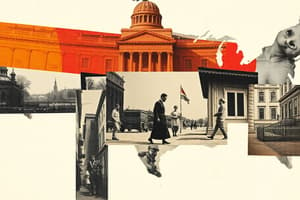Podcast
Questions and Answers
Which of the following is NOT a method employed in historical research?
Which of the following is NOT a method employed in historical research?
- Considering multiple viewpoints
- Historical context
- Source identification and evaluation
- Scientific experimentation (correct)
What is the primary difference between a primary and a secondary source in historical research?
What is the primary difference between a primary and a secondary source in historical research?
- Primary sources are always more reliable than secondary sources
- Primary sources focus on historical context, while secondary sources focus on historical bias.
- Primary sources are written by historians, while secondary sources are not.
- Primary sources provide firsthand accounts, while secondary sources offer interpretations of primary sources. (correct)
Why is it important to consider multiple viewpoints when examining historical events?
Why is it important to consider multiple viewpoints when examining historical events?
- To ensure objectivity and avoid bias in historical interpretations.
- To gather more information about the event from different perspectives.
- To understand the different motivations and actions of those involved.
- All of the above. (correct)
What is the most likely reason for evolving historical interpretations?
What is the most likely reason for evolving historical interpretations?
Why is it crucial to understand the historical context surrounding an event?
Why is it crucial to understand the historical context surrounding an event?
Which of the following is an example of a primary source in historical research?
Which of the following is an example of a primary source in historical research?
What is the primary function of historical periods?
What is the primary function of historical periods?
Why is it important for historians to acknowledge their own biases?
Why is it important for historians to acknowledge their own biases?
Flashcards
Historical Periods
Historical Periods
Distinct eras in history marked by significant events or changes.
Primary Sources
Primary Sources
Firsthand accounts or artifacts providing direct insights into an era.
Secondary Sources
Secondary Sources
Interpretations and analyses of primary sources written by historians.
Historical Methodology
Historical Methodology
Signup and view all the flashcards
Historical Bias
Historical Bias
Signup and view all the flashcards
Historical Context
Historical Context
Signup and view all the flashcards
Historical Figures
Historical Figures
Signup and view all the flashcards
Historical Interpretations
Historical Interpretations
Signup and view all the flashcards
Study Notes
Historical Periods
- History encompasses all past events, including human activity and societal changes throughout time.
- It explores the development of societies, cultures, and civilizations, examining interactions and transformations.
- Historical periods are organized into eras, using significant events like the Renaissance, Industrial Revolution, or Cold War as markers.
Historical Sources
- Historians use various sources to create historical accounts.
- Primary sources are firsthand accounts (diaries, letters, artifacts) offering direct insights into a specific time period.
- Secondary sources are interpretations and analyses of primary sources by historians, providing broader perspectives and context.
Historical Methodology
- Historical research uses specific methods to analyze evidence and interpret the past.
- Methods include identifying and evaluating sources, considering historical context, and acknowledging multiple viewpoints.
- Historians rigorously assess the reliability and trustworthiness of their sources.
Historical Figures and Events
- Significant figures and events shape historical narratives of different eras.
- Examining these helps understand political, economic, social, and cultural developments.
- Exploring key figures and events aids in constructing comprehensive historical accounts.
Historical Bias
- Historical accounts reflect the biases of historians and the societies that created them.
- Historians must acknowledge and critically analyze their own biases and those present in historical records.
- Acknowledging bias allows for a more nuanced interpretation of events.
Historical Context
- Understanding event circumstances (political, social, economic, cultural) is crucial for interpreting historical narratives.
- Context explains why events occurred and their long-term effects on society.
- Examining specific time periods helps understand events and avoid anachronistic interpretations.
Historical Interpretations
- Historical interpretations evolve over time due to new evidence and shifting perspectives.
- Understanding past events is continually reevaluated and refined with new research.
- Historians use diverse approaches and frameworks, including historical theories and perspectives, for interpretation.
Historical Narratives
- Historians create narratives from various sources to explain past events meaningfully and coherently.
- Narrative development follows a structural approach, sequencing events and analyzing them across eras.
- The narrative structure is driven by the historian's objectives or chosen study theme.
Studying That Suits You
Use AI to generate personalized quizzes and flashcards to suit your learning preferences.




